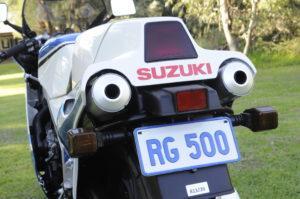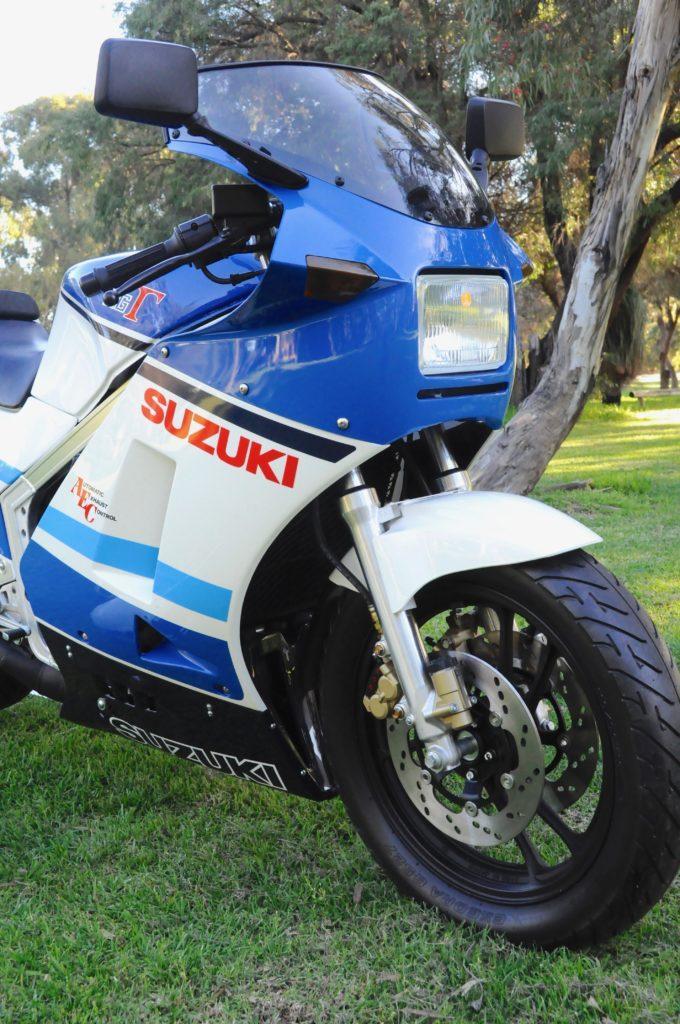
Republished from 2017
THIS is one extraordinary motorcycle. Built for show more than 30 years ago and apparently intended to have a high-profile but short-lived existence, it is a pre-production bike brought into Australia in 1985 to promote Suzuki’s much-anticipated but not-yet-released 500cc rotary-valve twin-crank four-cylinder 154kg 94-horsepower two stroke, the RG500.
The bike was rolled up-and-down trailer ramps and in-and-out of Suzuki dealerships, shopping centres and promotional events, drawing admiring stares and probably unleashing a cheque book or two as it did the rounds. But it was never ridden. The engine never started. And once the full-production model RG500 was released and bikes were available for sale, the show bike lost its reason to exist.
The bike you see here is owned by a Perth businessman who agreed to add a few more metres to the tiny mileage on its odometer so The Bike Shed Times could have a close-up look and take the photos you see with this article.
“Pre-production bikes are generally returned to head office and crushed,” the owner told us.

“This one somehow escaped that fate and was kept by Suzuki Australia as part of its ‘heritage collection’. A few years ago a decision was made to clear out the collection. I got wind of it, made an offer, and became the bike’s first owner — 32 years after it was made.”
A letter of authenticity from current Suzuki Australia Motorcycles Marketing Manager Lewis Croft confirms the bike’s history.
“Being a pre-production motorcycle, it has never been started, registered or used on Australian roads and never can be,” Mr Croft says in the letter, dated June 2014.
The owner told us the bike was dusty but otherwise in excellent condition when he took delivery.
“Some new and low-mileage classic bikes spend a lot of years in shop windows,” he said.
“The sunlight takes its toll on rubbers, plastics and paint, so sometimes low mileage bikes can be junk.
“But not this one.”
And he’s right.
The most extraordinary part of this blast from the past is the condition of the more fragile components.
The plastic and rubber parts, the paintwork, even the tiny metal spring clips that hold the fuel lines on the carburettors look as fresh as the day they were made. The foam surrounds around the gauges on the dash look like items that would have a very short life — yet they look good as new.

There is still assembly grease on fittings. The fine paint work on the brake components is sharp and bright.
So what’s it worth? Good question. The bike is for sale on eBay, and bidding has gone beyond $44,000 without reaching the reserve.
(UPDATE 14Sept2017: The eBay auction ended with a price just over $65,000 and did not sell.)


FOOTNOTE: We haven’t been able to track down any articles about pre-production motorcycles being crushed, but we did find an article about Chrysler USA crushing a bunch of pre-production 1993 Dodge Vipers. The story caused quite a stir among car buffs. You can read it here.

Also see
One Australian collector, two big two strokes. Story here.
In 1974, Suzuki changed the face of 500cc Grand Prix racing forever with the launch of the square-four RG500. Not only did this bike herald the arrival of the large-capacity two-stroke GP bike, but it went on to win seven consecutive 500 GP constructors’ championships, four world titles, 50 individual races, and allowed privateers to compete for GP glory on an equal footing with factory teams for the first time. – sportrider.com








